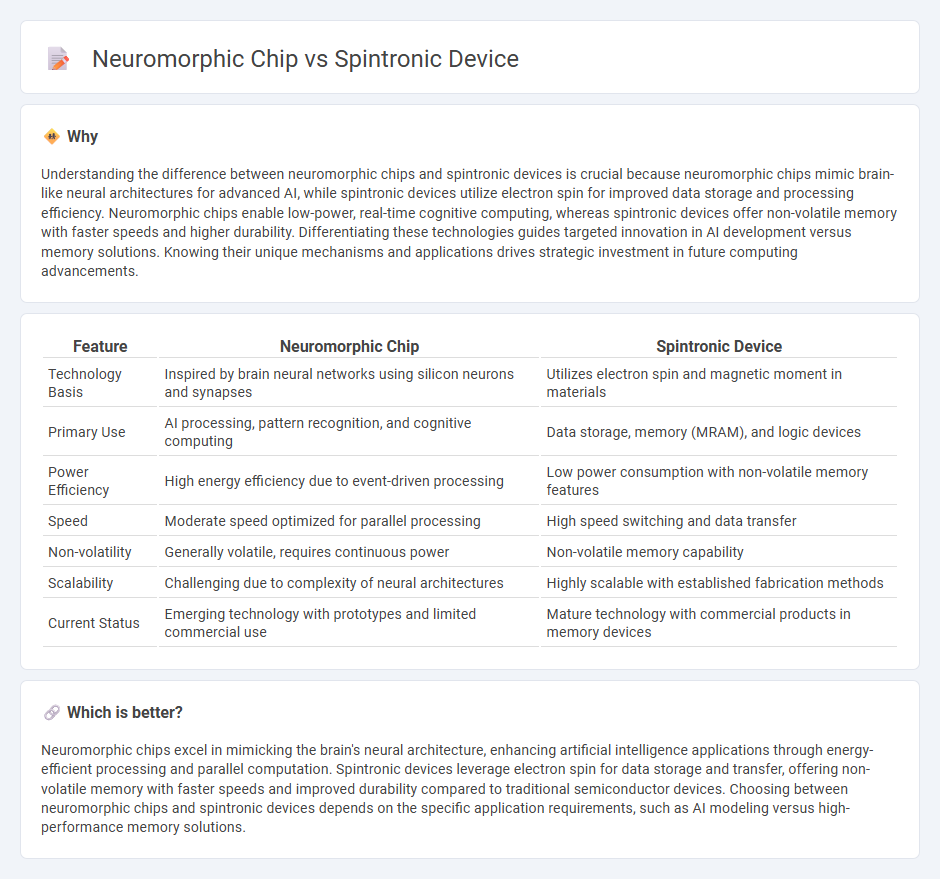
Neuromorphic chips emulate the human brain's neural architecture, optimizing processing for AI and machine learning through event-driven computation and low power consumption. Spintronic devices leverage electron spin and magnetic properties to enhance data storage, speed, and energy efficiency in next-generation memory and logic applications. Explore the differences between these groundbreaking technologies to understand their impact on future computing innovations.
Why it is important
Understanding the difference between neuromorphic chips and spintronic devices is crucial because neuromorphic chips mimic brain-like neural architectures for advanced AI, while spintronic devices utilize electron spin for improved data storage and processing efficiency. Neuromorphic chips enable low-power, real-time cognitive computing, whereas spintronic devices offer non-volatile memory with faster speeds and higher durability. Differentiating these technologies guides targeted innovation in AI development versus memory solutions. Knowing their unique mechanisms and applications drives strategic investment in future computing advancements.
Comparison Table
| Feature | Neuromorphic Chip | Spintronic Device |
|---|---|---|
| Technology Basis | Inspired by brain neural networks using silicon neurons and synapses | Utilizes electron spin and magnetic moment in materials |
| Primary Use | AI processing, pattern recognition, and cognitive computing | Data storage, memory (MRAM), and logic devices |
| Power Efficiency | High energy efficiency due to event-driven processing | Low power consumption with non-volatile memory features |
| Speed | Moderate speed optimized for parallel processing | High speed switching and data transfer |
| Non-volatility | Generally volatile, requires continuous power | Non-volatile memory capability |
| Scalability | Challenging due to complexity of neural architectures | Highly scalable with established fabrication methods |
| Current Status | Emerging technology with prototypes and limited commercial use | Mature technology with commercial products in memory devices |
Which is better?
Neuromorphic chips excel in mimicking the brain's neural architecture, enhancing artificial intelligence applications through energy-efficient processing and parallel computation. Spintronic devices leverage electron spin for data storage and transfer, offering non-volatile memory with faster speeds and improved durability compared to traditional semiconductor devices. Choosing between neuromorphic chips and spintronic devices depends on the specific application requirements, such as AI modeling versus high-performance memory solutions.
Connection
Neuromorphic chips and spintronic devices intersect in advanced computing through their shared focus on mimicking neural processes using spin-based electronics. Spintronic devices utilize electron spin to achieve low-power, high-speed data processing, which aligns with neuromorphic chips' goal of efficient brain-inspired computation. This synergy enhances the development of artificial intelligence systems by enabling adaptable, energy-efficient neural network architectures.
Key Terms
Spintronic device:
Spintronic devices leverage the electron's spin state alongside its charge, enabling non-volatile, energy-efficient memory and logic operations that surpass traditional CMOS technology in speed and endurance. These devices are integral to next-generation computing architectures due to their potential for high-density data storage, improved thermal stability, and reduced power consumption in applications such as MRAM and spin-torque oscillators. Explore the unique advantages of spintronic devices and their transformative impact on future computing by learning more about their principles and implementations.
Magnetoresistance
Spintronic devices exploit magnetoresistance effects, such as giant magnetoresistance (GMR) and tunneling magnetoresistance (TMR), to achieve efficient data storage and sensing by manipulating electron spin. Neuromorphic chips, on the other hand, use magnetoresistive elements to emulate synaptic plasticity and neuronal behavior for brain-inspired computing architectures. Explore the latest breakthroughs in magnetoresistance technologies driving innovation in both spintronic devices and neuromorphic chips.
Spin torque
Spintronic devices leverage spin torque to manipulate electron spin, enabling non-volatile memory and logic operations with high speed and low power consumption. Neuromorphic chips incorporate spin torque mechanisms to emulate synaptic plasticity, enhancing computational efficiency in brain-inspired architectures. Explore the advancements in spin torque applications within spintronic and neuromorphic technologies for cutting-edge innovations.
Source and External Links
Spintronic Devices for Energy-efficient Computation (a closer look) - Spintronic devices, such as magnetic tunnel junctions (MTJs), use the spin of electrons in addition to their charge to store and process information with high energy efficiency and non-volatility, making them promising for next-generation memory and switching applications.
Introduction to Spintronics - UMD Physics Department - Spintronics explores devices that exploit electron spin properties in solid state physics, with practical examples like giant-magnetoresistance (GMR) sensors and memory cells, where device resistance changes based on the relative magnetization orientation of ferromagnetic layers.
Spintronic Devices upon 2D Magnetic Materials and Heterojunctions - Recent advancements focus on two-dimensional (2D) magnetic materials for spintronic devices, enabling ultra-low-power, high-density storage and fast data transmission through mechanisms like spin-orbit torque (SOT) and giant tunneling magnetoresistance (TMR) in heterojunctions.
 dowidth.com
dowidth.com